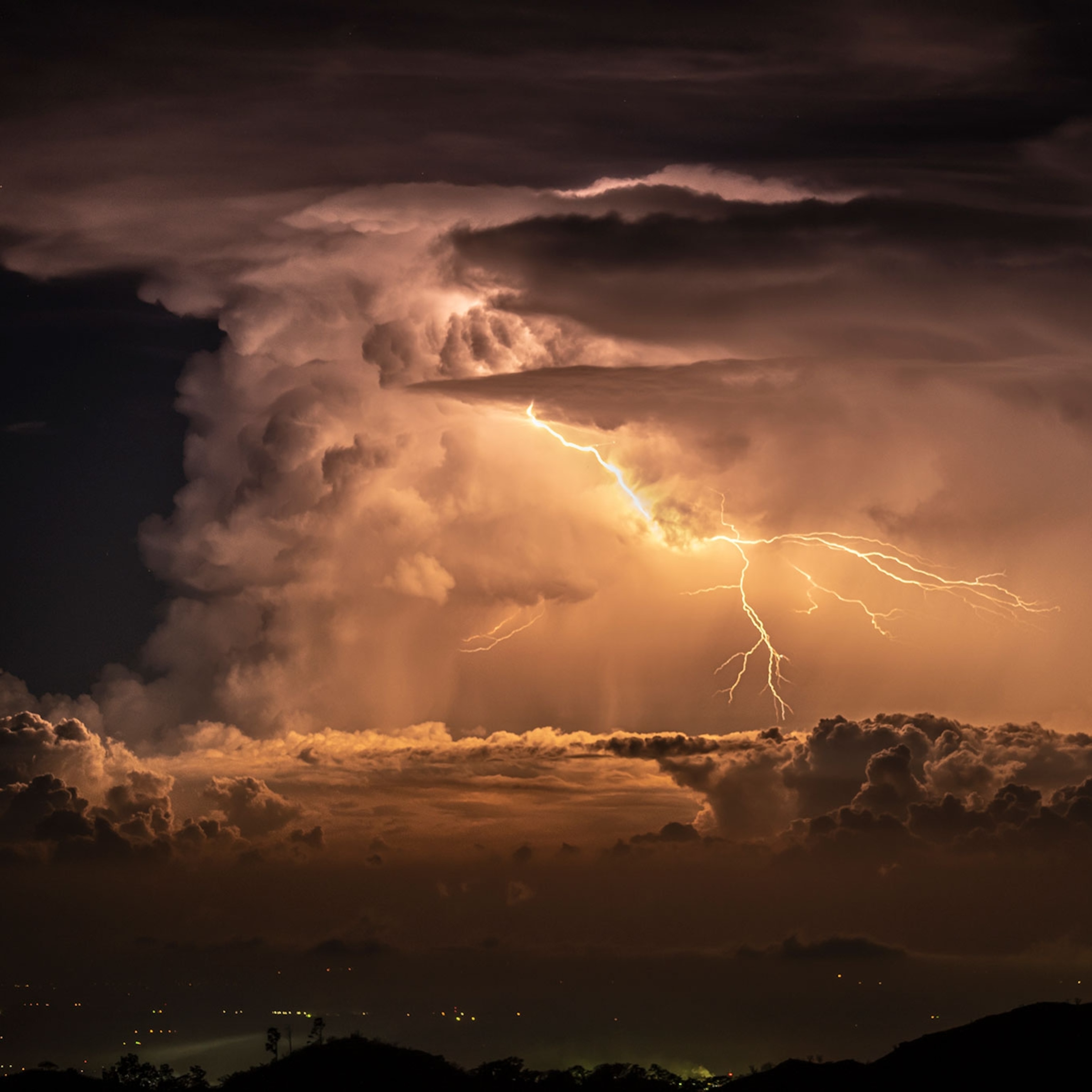
How to Survive a Lightning Strike? Stay Out of Its Way.
Hundreds of people are struck by lightning each year while camping, hiking, and boating. Here’s how to stay safe when you’re savoring summer in the great outdoors.
Adam Campbell was 1,312 feet (400 meters) from the summit of a peak in Colorado’s San Juan Mountains when the weather shifted. The experienced mountain ultrarunner was competing in the 2014 Hardrock One Hundred Endurance Run, one of the world’s toughest trail races, and he knew what to expect when he ran in the high country in the heat of a July afternoon. But even he was caught off guard when the spectacular sunset gave way to darkening skies, a sudden drop in temperature, and kicked-up winds.
“Off in the distance, I could see lightning, but it seemed a long way off,” Campbell recalls. Above the tree line at 14,000 feet (4,267 meters), he and his pacer, Aaron Heidt, saw no natural cover from the coming storm. Then they watched a lightning bolt strike the summit ahead of them.
“I was fully exposed, and about three miles from real shelter at that point. I knew my best bet was to get up and over the peak to a boulder field on the other side,” Campbell says. “Normally I’d try to get down the mountain, but I was 60 miles into the race, and I didn’t have many options. I took a calculated risk.”
Suddenly, another bolt hit the ground near them. “It sounded like a mortar shell going off. There was an electrical, burning, ozone-like smell in the air. My headlamp exploded—the current went through me,” Campbell says.
The shock threw Campbell and Heidt to the ground, but they were not physically hurt. Campbell, having run more than half of the race and now exposed to cold and rain in addition to the jolt of electricity, talked himself down from a flood of panicky emotions. After reaching a sheltered location farther down the mountain and checking himself for signs of injury, he was able to finish the race in third place—with no lasting side effects.
They were both extremely lucky. Campbell was one of the hundreds of people who are struck by lightning in the United States every year, but fortunately, not among the approximately 30 annual lightning fatalities.
According to the National Weather Service, almost two-thirds of lightning fatalities occur as people enjoy leisure activities in the outdoors—and deaths are concentrated in the summer months. Of 313 deaths between 2006 and 2015, 33 happened as the victims were fishing, 17 while camping, and 14 while boating. Eighteen fatalities took place on beaches.
An analysis by the weather service found that many victims were either headed to safety or “just steps away” from shelter when they were hit—so planning for the possibility of a lightning event is essential if you’re on an outdoor adventure, says John Jensenius, a meteorologist and the agency’s lightning safety expert.
“There is no safe place outdoors,” Jensenius says. He offered adventurers these tips for staying safe—and alive—this summer.
Keep an eye on the sky.
Checking the weather forecast is the first and simplest thing people should do to avoid encounters with lightning. In most regions of the United States, thunderstorms usually occur in the afternoon or evening. Start your hike or kayak expedition in the morning, and finish up by noon if the forecast indicates bad weather ahead. If the forecast calls for periodic storms throughout the day, “make a smart choice and consider canceling the trip,” Jensenius says.
Form a safety plan.
Before you head out, check maps to locate visitors centers, campground buildings, or rest areas along your route. As you’re hiking or paddling, watch continually for the nearest shelter. Car campers can take cover in their metal-topped vehicles if no other shelter is available (do not wait out the storm in a tent). Make sure you know the location of the closest refuge and how long it will take you to reach it if a storm arises. Most importantly, don’t wait to use your safety plan if you hear thunder, see lightning, or sense that a storm is approaching. “If thunder roars, get indoors” is Jensenius’ easy-to-remember tip.
Know the storm’s distance.
It can be difficult to see coming storms in mountainous areas, he says, but it’s possible to gauge a storm’s distance when you see the first flash of lightning. Count the seconds between the flash and the ensuing rumble of thunder. (When the electrical current from lightning superheats the air around it, the air molecules expand explosively, creating a sonic shock wave—that is, thunder.) Divide the number of seconds by five to calculate the number of miles between you and the storm. To calculate kilometers, divide by three. If the number of seconds is 30 or fewer, equaling six miles or 10 kilometers, find shelter immediately. As a general rule, “You can hear thunder at a distance of 10 miles, and if you hear it, get indoors as soon as possible,” Jensenius says.
Don’t be the tallest object.
Lightning tends to strike the tallest object in an area, whether it’s a tree, a mountain, or you. In 1985, lightning killed two and injured three people on Half Dome in Yosemite National Park, and in 2014, two hikers died on high-altitude trails in Rocky Mountain National Park. If you’re climbing and a storm is brewing, descend to a lower elevation quickly (avoid touching metal guardrails or steps, which conduct electricity) and find shelter right away. If you’re on the water, get to shore fast. When there’s no place to take cover, crouch on the balls of your feet to lessen your contact with the ground, with your head down and hands over your ears. “The position lowers you from the size of an adult to a child,” Jensenius says. “You can’t eliminate the risk, but you can help minimize it.”
- National Geographic Expeditions
Don’t be next to the tallest object.
Many lightning victims are struck when standing too close to isolated tall objects, such as lone trees. In a phenomenon called a “side splash,” lightning strikes the tree directly, and as the current travels downward, it jumps to nearby structures or people. The current can also radiate from the point where the tree meets the ground, zapping things many feet away. For those reasons, you should never huddle under a tall tree in a storm. If you’re caught in a forest or wooded area, seek out a clump of smaller trees and get away from the bigger specimens. Alternately, find a dry ravine or valley and crouch down (don’t lie flat, which increases your contact with a potential ground current).
Spread out from the pack.
If you’re hiking or climbing in a group, Jensenius recommends staggering your positions to avoid traveling in a tight company. That way, if lightning strikes a nearby tree or rock and travels across the ground, there’s a chance that fewer people will get shocked. They, in turn, will be available to help the injured.
Wait 30 minutes to venture out.
Storms can last from around 30 minutes to an hour and a half, Jensenius says. Even if you’re caught in the early part of the storm, you should still head for safety to wait out the rest of it. He also recommends staying put until 30 minutes after the lightning, thunder, and rain has subsided.






